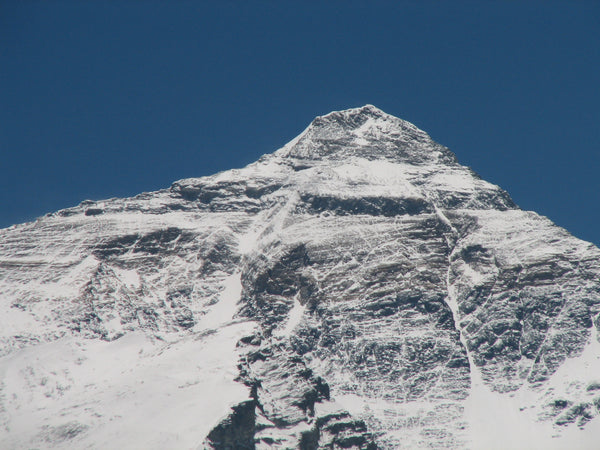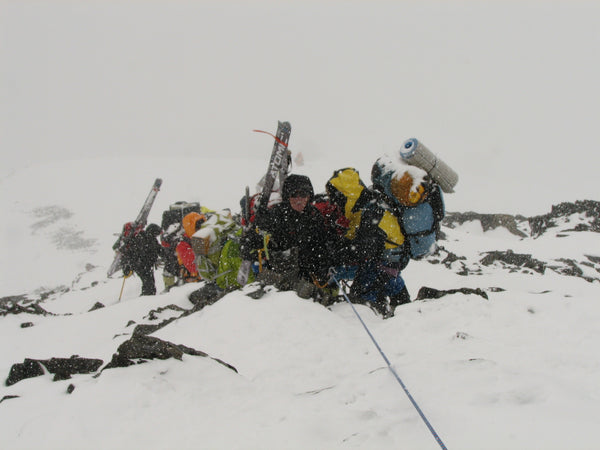By Mike Marolt
With the reports coming in of up to as many as 100 people being stranded and killed in Nepal recently, and considering the tragic deaths of 16 Sherpa on Everest in a single event tragedy this past May, the subject has reached high levels of media and there are obviously a lot of questions to be asked and issues to be handled. However, when you look at the history of these types of massive single event tragedies over the past 15 years, this is not a case of isolated bad luck associated with the inherent dangers of being in the highest peaks on earth. This is an epidemic of sorts that warrants a serious look at why and how people are heading out to see these amazing places.

Commercialism flourishing on upper Everest......
The greater Himalaya has always been a magnet for mountaineers at the highest levels to take on as the ultimate proving grounds to test lifetime ambition to learn the ropes. However, in their progress to attain summits in the highest range, the technology has also evolved. In that evolution, the best climbers in the world realized that they could tap into the general public and find people that simply wanted to go. This allowed for climbers to bring people to base camp and in the process, finance their climbing expeditions by charging a premium to tag along. People flocked to get onto expeditions to join the climbers and to experience the magnitude and beauty of the Himalaya. As the generation of climbers aged out of the game, they realized there was an endless number of people that still wanted to go, and the advent of commercial guiding took root. One only has to look at the list of owners that now operate guide services to see that they are a hit list of some of the best climbers of their day.
Soon however, as more and more climbers took to the new industry, the game became very competitive. There was a need to separate companies with new and exciting offers to do more than just trek. These companies realized that they could use local Sherpa to haul client gear, and use supplemental oxygen to make climbing at altitude possible. People started experimenting with various drugs to help eliminate the effects of altitude. By the lat 1990's, guide companies realized if they fixed ropes up entire routes, the market for people that wanted to climb was abundant, and the summit race was borne. Guide companies took advantage of the internet to market expeditions and trips even highlighting summit success percentages. The prices were exorbitant but the demand was never in question. By the year 2010, the number of people that has stood on the summit of Everest ballooned from a few hundred in 1990 to a few thousand.
In the evolution, however, there is another aspect that is often not noticed. For example, in 2003, when i first set foot on Everest, i remember a guide talking to his clients and discussing the use of supplemental oxygen. He told them that they had a mere 3 bottles allocated, and that they were not to use it until a specific altitude, and not to exceed a certain flow rate. He was clear that by exceeding these directions, not only would clients run out, but they would also be "cheating" acceptable standards. By the year 2013, guide companies have designed "super efficient high flow oxygen masks" and for a typical client on Everest, they are provided with 12 bottles but can purchase more if needed. So even within the existing infrastructure, over the years, ethics have been replaced with a desire to make, as one guide explained to me, "the experience as comfortable as possible".
What has been lost in the evolution, however, is the ramifications of the industry. It's a simple fact that when ethics become diluted, there are costs. Take oxygen for example. A bottle of oxygen weighs about 6 pounds. So for a climber to have 12 bottles, that is a weight factor of 72 pounds. To put that in perspective, it is the equivalent of hauling 10 tents, per person, to the highest camps on the mountain. However, the clients are not carrying that additional weight. A typical commercial expedition to Everest plans on a whopping 3.5 Sherpa for each client. So not only are the mountains congested with hundreds of clients, the armies of Sherpa to support those climbers is astounding. In short, while climbing is without question more comfortable, what we are seeing are massive crowds on single routes that typically only saw a handful of climbers. The result is abuse of the environment with trash and waste, and massive crowds in the heart of what is an inherently dangerous place to be to begin with. Bottle necks form on routes, and while it is comfortable, it is exposure where before there was not as much.
The larger issue, however, is that while the commercial guide industry has flourished, there is by and large no regulation whatsoever, and with the combined lack of ethical climbing standards being diluted, what is happening is that the crowds that are overwhelming the routes are by and large lacking any level of experience that once was inherent just to realistically consider going to the Himalaya. The only thread of regulation is common sense which is often trumped by the revenue stream. Many guide companies will take anyone. Where there used to be unwritten resume requirements to be considered for inclusion for an expedition, if someone wants to go bad enough and has the money, they are in. The notion of ease of entry and fact that people from 13 to 70 as well as people with a wide variety of conditions have been provided the means to attain the summits of the highest peaks, if you can pay the ticket, there is a guide that will take you.

The North Face of Everest. Being self sufficient is essential regardless of hiring a guide...
The irony of the situation is that along with the evolution of this commercialism, the death counts are spiking at levels unprecedented in any other adventure activity. It stands to reason that with more people there will be inherently more deaths, but when you look at the last 15 years, the statistics are staggering. Over the past decade or so since the infamous 1996 tragic year where 14 people lost their lives on Everest with 12 from a single 45 minute storm, the peak has never seen fewer than 4 deaths in a season. Some astounding counts over those years include 7 deaths in 2004, 6 deaths in 2005, 11 deaths in 2006, 10 deaths in 2012, 8 deaths in 2013. Manaslu, another popular 8,000 meter peak has seen at least 2 deaths every year for almost 20 years with many years seeing more, and with 11 climbers dying in a single event avalanche in 2012. K2 has recently been added to the list of commercially guided peaks and in 2008 saw a record 11 deaths in a single event avalanche on the upper reaches of the mountain.
So what we are seeing is a gradual increase in the number of people dying as the years go by, often as was the case this season when 16 Sherpa lost their lives, in single event tragedies where large numbers of people at one time are in the paths of naturally occurring avalanches or single storms. These peaks have never been free of deaths, but how we have engineered them has, and along with this, the masses of people are flocking to seek their dreams. With the mass, the inherent danger of the environment is not more deadly, but more people are placing themselves in harm’s way, so the numbers are increasing. It appears that death is not serving to be a deterrent, but rather it has served to communicate that just about anyone can try. Despite the massive death toll, the message is clear. Climbing the highest peaks in the world is available to just about anyone.

Log jam on the North Ridge of Everest....
This past week was yet another example of the epidemic. While the number of people heading to the Himalaya to climb the highest peaks is astronomical, it is still a very small number relative to society in general. However, over the same period that mountaineering flourished, the same commercialism has tailored business to tap into the less adventurous sectors of society in the form of trekking expeditions into the Himalaya. This has further increased the masses heading into the highest peaks on the planet. But the same issues and inherent dangers still exist. You don't have to be on a high peak to be exposed to what a mountain range can throw at you. When in the Himalaya, even more so. There is no argument that climbing is more risky than trekking, but the fact remains that when trekking in the Himalaya, you are doing a seemingly casual act of walking in the hills which by and large is accommodated with the experience of the thousands that have walked before you. However, it is still in the Himalaya, and what we saw this past week is the ultimate example of what happens when people approach the Himalaya casually. The latest reports are that a "freak" storm hit the Annapurna circuit, one of the most popular trekking routes in the range, in a storm that dumped as much as 6 feet of snow. 100 people are missing, most presumed dead from avalanches and exposure. When the storm hit, it was simply a matter of many many people not being prepared to wait out the storm with proper gear and supplies. Being unprepared forced people to head down the valleys exposing them to endless slopes of steep terrain covered in a massive amount of unstable snow.
The key factor is the term being used, "freak storm". Without even looking at the facts, it doesn't take much experience to know that when you head into the highest peaks in the world, if you are not prepared for anything that the mountains can throw at you, you are simply not respecting the situation enough to take care of yourself. But when one looks at the facts, the disaster becomes even more apparent. Not only had major weather forecasts predicted the storm a week in advance, but it is neither freak or an anomaly. The entire range has examples of similar storms since the beginning of time, but the Annapurna range is a notoriously heavy snow part of the range. Add to this that these treks are outfitted with Sherpa to haul literally everything for a trek, there is no good excuse for not having the minimal essentials to accommodate what is not really freakish, but at a minimum possible. The fact that it has not happened often in recent years is by no means a justification for taking these trips casually which has been the case based on the tragedy. Cruising the internet, the numbers of trekkers to loose their life has gradually been on the increase with similar stories as this week, although not to the magnitude, of these freak storms happening from time to time. Point being, these are mountains and it can and will snow. To not heed this reality is a simple lack of either knowing what you don't know or rolling the dice over something that is guaranteed to be possible. Even if one argues this is a freak storm, it's not the first freak storm and it won't be the last.
In the Lonely Planet guide book for Nepal, there is a line of advice. When trekking in Nepal, always hire a reputable guide. While I am not purporting to be anti guide, what i would add to that is that when a guide has a dozen clients and it snows 6 feet, he won't be able to save everyone if they are not prepared to handle the situation to a degree on their own. The right of passage once earned to enter the Himalaya has been totally sold out in the name of hiring a guide. Whether it be for trekking or even climbing the highest peaks, the industry has garnered a reputation for being the end all in your safety and people have come to place 100% assurance on a guide's ability to make the adventure safe. Trips are sold under the guise of a company’s experience and ability to get you up safely. But without taking personal responsibility, there really is no way this is feasible. It would be akin to thinking it is possible to go to Harvard without a high school diploma, but someone will give you all the homework and answers to graduate. The chances of getting caught are high only when you get caught in the Himalaya, you can get kicked out of life itself.
In principle, the value of hiring a good guide cannot be disputed. Their experience can be the difference between a great trip and a disaster on many levels. However, without respecting the environment that one places themselves in when they go to the Himalaya and taking it seriously enough to do a bit of homework before they go, is prelude to what has occurred this month on the Annapurna circuit. The fact that many of the hundred people killed and hurt in that tragedy were with guides should serve as an example that having a guide is not the end all. One has to look ahead and ask basic questions. What if the guide makes a mistake? What if the guide gets killed? If you don't have the answers to these basic questions, or if you do not have the experience or skill set to handle being in the HImalaya completely on your own in good times and bad, then you put yourself at serious risk and also place an almost impossible burden on the guide should the worst case scenario happen.
The mountains don't care who you are, if you have a guide or even if you are a guide. So it is critically important to go into these places with enough experience to handle whatever comes up. That includes having the experience needed to understand what gear you need to take and how to use it if the need arises. That includes reviewing the guides gear inventory before you get to the trail head. Reputable guides that have experience generally do a good job of outfitting expeditions, but they are human. They make mistakes. In my own experience, on one trip, we failed to look at the gear and when we got to the trail head, we found that our guide company failed to throw stoves into the load. Check your own personal gear, but also go over the group gear before you head out. Make sure you take responsibility for your own trip.
Once on the trail, you also need to have the experience to question the guides. Again, they make mistakes. If you don't have the experience to vest yourself in the process of your trip, to follow basic protocol in the mountains, you eliminate completely the factor that cares more about you than anyone, YOURSELF. It's about respecting the mountains and taking charge of your own destiny. It's also about being honest with yourself. If you don't have the experience or ability to go into the Himalaya and survive under the worst case scenario, you probably should not go. Climbing and trekking is a natural progression. The irony is that the only way to obtain experience for these trips is to is to do them. So as the saying goes, you start out on hills and work your way up to mountains. There are simply no shortcuts in the mountains, and while going with people with more experience or guides is a great way to learn by example, experience is a step by step process. No one can do that for you. You have to pay your dues in any mountains. The commercialism of the greatest ranges is in fact a process that brings access and comfort to accommodate the masses. The industry has by and large taken the model used by Disneyland and applied it to the mountains. Only in the mountains, the rides starts the minute you take your first step. If you are not prepared for everything, it's tough to get off the ride.....



Pat Bingham
Nice article. Well said.
PB